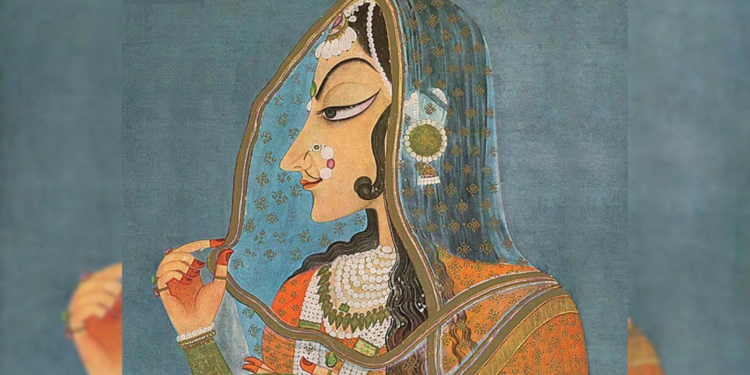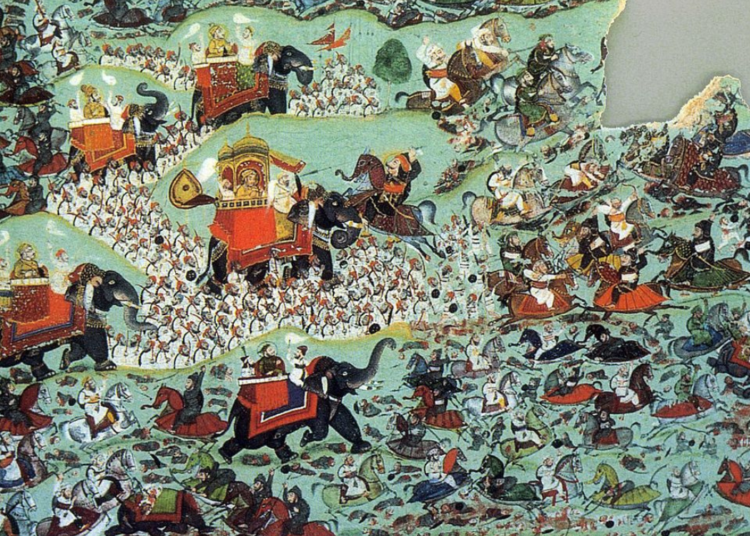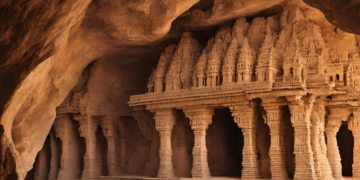In the heart of India’s artistic tapestry, where vibrant colors dance with intricate details, lies a tradition that has captured the essence of an era long past. Welcome to the enchanting world of Rajput paintings, where the strokes of a brush tell stories that have transcended centuries. This canvas, adorned with the hues of tradition and heritage, is a testament to the soulful expression of Indian artistry.
Rajput paintings, like echoes from a bygone era, beckon us to embark on a journey through time—a journey that unveils the hidden narratives behind 10 iconic masterpieces. In this exploration, we’ll traverse the majestic courts of Rajasthan, where these artistic gems were born, and breathe life into their captivating stories. So, join us as we unravel the rich history and narratives concealed within these famous Rajput paintings, each a window into the traditional artistry that defines India’s cultural heritage.
The Origin and Significance of Rajput Paintings
The story of Rajput paintings unfolds against the backdrop of medieval India, where kingdoms flourished and chivalry was revered. These artistic marvels, born during the late 16th and early 17th centuries, were nurtured in the regal courts of Rajputana, the land of valiant warriors and poets.
Amidst the echoes of swords clashing in battles and the melodies of courtly love, Rajput paintings found their genesis. Influenced by both Hindu and Mughal painting styles, they soon emerged as a distinctive school of art. The Rajputs, renowned for their martial prowess, channeled their creative spirit into these paintings, creating masterpieces that vividly depicted their culture and history.
Rajput paintings are known for their vibrant colors, intricate details, and expressive figures. They often depict scenes from Hindu mythology, Rajput history, and court life. Some of the most famous Rajput paintings include:
- Rasamanjari: This 17th-century painting depicts the Indian love god Krishna dancing with his gopis (cowherd girls). It is considered one of the finest examples of Rajput painting.
- Bhagavata Purana: This series of paintings from the 17th century illustrates the Bhagavata Purana, a Hindu religious text. It is one of the largest and most ambitious works of Rajput art.
- Hamza-nama: This series of paintings from the 16th century illustrates the Hamza-nama, a Persian epic poem. It is one of the most important works of Rajput painting from the Mughal period.
Rajput paintings are significant for a number of reasons. Firstly, they are a valuable record of Rajput history and culture. Secondly, they are masterpieces of Indian art, admired for their beauty and craftsmanship. Thirdly, they have had a profound influence on other forms of Indian art, such as Mughal painting and folk art.
In addition to their cultural and artistic significance, Rajput paintings are also important for their role in promoting religious tolerance and understanding. Rajput rulers were patrons of both Hindu and Islamic art, and their paintings often depict scenes from both religions. This helped to foster a spirit of religious tolerance and harmony in the Rajput kingdoms.
Exploring the Masterpieces and Stories of Iconic Rajput Paintings

1) Title of Painting: Bani Thani
Artist: Nihal Chand
Date: 1760-1780
Medium: Miniature Painting
Description of Painting: “Bani Thani” is a captivating miniature painting that portrays a resplendent woman dressed in intricate Rajput attire and adorned with exquisite jewelry. Her striking features, elegant poise, and graceful expressions captivate the viewer. The painting is a testament to the artistry and attention to detail that characterizes Rajput miniature art.
Story Behind the Painting: The subject of the painting, Bani Thani, was a courtesan in the Rajput court of King Sawant Singh of Kishangarh. She was known for her unparalleled beauty and charm, which earned her the title “Bani Thani,” meaning “the well-dressed lady” or “the beautiful lady.”
The artist, Nihal Chand, was inspired by Bani Thani’s enchanting allure and chose to depict her in this masterpiece. While the painting portrays her as a beautiful royal courtesan, it is believed that Bani Thani was a mysterious figure in the Kishangarh court and may have been a poetess or an accomplished musician as well.

2) Title of Painting: “Krishna Playing the Flute with Radha and the Gopis”
Date: 17th century
Medium: Miniature painting
Description of Painting: This exquisite Rajput painting, belonging to the Mewar school, captures the enchanting scene of Lord Krishna playing the flute in the company of his beloved consort Radha and the gopis, or cowherd girls. The painting is a visual symphony of vibrant colors, intricate details, and a lush, verdant landscape that transports the viewer to the idyllic world of devotion and love.
Story Behind the Painting: The painting portrays a timeless and beloved episode from Hindu mythology and folklore. Lord Krishna, the divine cowherd, and eternal lover, enthralls Radha and the gopis with his melodious flute music. His music transcends earthly boundaries, stirring the hearts of all who hear it. The scene epitomizes the divine love between Krishna and Radha, which symbolizes the union of the individual soul with the divine.

3) Title of painting: “The Royal Family of Jaipur”
Date: 19th century
Medium: Rajput miniature painting
Description of painting: This exquisite Rajput painting hails from the renowned Jaipur school and offers a captivating glimpse into the opulence of the royal family of Jaipur during the 19th century. In the painting, the entire royal family is elegantly seated together on a grand terrace. Each member is adorned in resplendent clothing and adorned with intricate jewelry, reflecting the magnificence of the Rajput court. The artist’s meticulous attention to detail is evident in the lifelike portrayal of the figures, capturing their regal grace and charm.
Story behind the painting: This painting serves as a visual chronicle of the royal family of Jaipur during the 19th century. It commemorates a significant moment in their history, perhaps a celebratory occasion or a family gathering. The artist, while rendering this masterpiece, aimed to capture not just the physical likeness of the family members but also the essence of their noble heritage.

4) Title of Painting: “The Arrival of Spring”
Date: 19th century
Medium: Rajput miniature painting
Description: “The Arrival of Spring” is a captivating masterpiece from the Kishangarh school of Rajput painting. The painting is a vivid celebration of the changing seasons, bursting with vibrant colors and a profusion of flowers. At the heart of the artwork, a group of women joyously dances, their graceful movements, and radiant smiles reflecting the exuberance of the new season. The landscape is adorned with blossoms in full bloom, creating a mesmerizing visual spectacle.
Story behind the Painting: This enchanting painting captures the essence of spring, a season that symbolizes renewal, growth, and the triumph of life over the dormancy of winter. The women in the painting are depicted reveling in the arrival of spring, celebrating nature’s awakening and the promise of abundance that it brings. The depiction of dance and celebration signifies the joyous spirit of the Rajput people during this time of the year.

5) Title of Painting: “Ragamala: The Raga of Spring”
Date: 17th-18th century
Medium: Miniature Paintings
Description of Painting: “Ragamala: The Raga of Spring” is a mesmerizing collection of miniature paintings, each a vibrant and intricate representation of classical Indian music. The artworks are rich in color and detail, evoking a sense of rhythm and melody. Each painting is a visual celebration of a specific musical mode, or raga, capturing the essence of that raga’s emotional landscape.
Story Behind the Painting: These miniature paintings are part of the larger Ragamala tradition in Rajput art. The Ragamala, which translates to “Garland of Ragas,” is a poetic and visual exploration of the emotional nuances of classical Indian music. Each painting is dedicated to a specific raga, and through intricate details, colors, and symbols, it seeks to convey the mood, time of day, and season associated with that raga.

6) Title of Painting: “The Battle of Haldighati”
Artist: Sahibdin
Date: 17th century
Medium: Watercolor on paper
Description of Painting: “The Battle of Haldighati” is a vivid and dramatic portrayal of the historical conflict that took place between Maharana Pratap of Mewar and the Mughal emperor Akbar’s forces. The painting captures the intensity of battle, with warriors on horseback and elephants engaged in fierce combat. The Haldighati Pass, marked by its distinctive yellow soil (haldighati), serves as the backdrop for this epic confrontation.
The story behind the Painting: The Battle of Haldighati, fought in 1576, was a pivotal moment in Rajput history. Maharana Pratap, the valiant Rajput warrior, faced off against the mighty Mughal army led by Raja Man Singh. Despite being outnumbered, Maharana Pratap’s unwavering courage and determination became legendary. The painting commemorates this heroic battle, depicting the Rajputs’ resilience and their fierce defense of their homeland against the Mughal forces.

7) Title of Painting: “The Gita Govinda”
Date: 17th century
Medium: Miniature painting
Description of Painting: “The Gita Govinda” is a mesmerizing miniature painting that captures the divine romance between Lord Krishna and Radha. Set against a lush, ethereal backdrop of Vrindavan, the painting portrays Lord Krishna, adorned with peacock feathers and a vibrant turban, playing his enchanting flute. Radha, the epitome of grace and beauty, stands in a tender pose, her eyes locked in devotion towards Krishna. The scene exudes an otherworldly aura, with the divine lovers surrounded by delicate flora and celestial beings, immersed in an eternal dance of love.
Story Behind the Painting: This painting is inspired by the “Gita Govinda,” a 12th-century Sanskrit text composed by Jayadeva, a renowned Indian poet. The Gita Govinda narrates the profound love and spiritual union between Lord Krishna and Radha, often allegorically representing the union of the human soul with the divine. In this specific scene, Lord Krishna’s melodious flute-playing draws Radha and the gopis (cowherd girls) of Vrindavan towards him, symbolizing the soul’s yearning for union with the divine.

8) Title of Painting: “Raghuraj Singh Hunting Tigers”
Date: 18th century
Medium: Miniature Painting
Description of Painting: The painting “Raghuraj Singh Hunting Tigers” is a stunning Rajput miniature masterpiece that vividly captures the grandeur and bravery of the subject. In this artwork, Raghuraj Singh, a prominent Rajput nobleman, is portrayed on horseback, adorned in regal attire, and armed with a spear. He is shown in the midst of a fierce tiger hunt, a perilous pursuit amidst the lush Rajputana landscape.
Story Behind the Painting: The painting narrates the valorous escapades of Raghuraj Singh, a celebrated Rajput warrior known for his fearlessness in the face of danger. Tiger hunting was a popular sport among Rajput nobility, symbolizing their courage and hunting prowess. Raghuraj Singh’s reputation for his skill and daring in hunting these formidable creatures earned him legendary status.
Significance of the Painting: This painting holds significant cultural and historical value. It showcases the Rajput tradition of tiger hunting, emphasizing the bravery and chivalry associated with Rajput warriors. Such paintings not only glorify the courage of the subjects but also provide insights into the Rajput way of life, their love for adventure, and their passion for preserving their territories from wildlife threats.

9) Title of Painting: “Siege: The Battle of Chittorgarh”
Date: 16th century
Medium: Miniature painting
Description of Painting: This exquisite miniature painting captures a pivotal moment during the Siege of Chittorgarh. It depicts the imposing fort of Chittorgarh surrounded by the Mughal forces, with cannons and artillery poised for attack. Within the fort’s walls, Rajput warriors stand resolutely, defending their stronghold.
Story Behind the Painting: The Siege of Chitorgarh was a historic battle in 1567-1568 when the Mughal emperor Akbar laid siege to the formidable Chitorgarh fort, ruled by Rana Udai Singh II. The painting narrates the intense struggle between the Rajputs and the Mughals, with the former displaying incredible valor and determination.

10) Title of Painting: “The Emperor Akbar in the Court of Jahangir”
Date: 17th century
Medium: Miniature painting
Description of Painting: This exquisite miniature painting portrays Emperor Akbar, one of the most illustrious rulers of the Mughal Empire, in the court of his grandson, Jahangir. The artwork is replete with intricate details, depicting Akbar in his regal attire, seated on an opulent throne adorned with rich fabrics. Jahangir, with a falcon perched on his wrist, stands in respectful homage to his esteemed grandfather. The court is surrounded by nobles, scholars, and courtiers, all captured in vibrant colors and meticulous brushwork.
Story Behind the Painting: This painting narrates a significant historical moment in the Mughal Empire. Emperor Akbar, renowned for his visionary rule and religious tolerance, is depicted here in the later years of his life. He was instrumental in expanding and consolidating the Mughal Empire, leaving behind a legacy of administrative reforms and cultural achievements. Jahangir, who succeeded him, pays homage to his grandfather’s wisdom and leadership. This painting symbolizes the continuity and grandeur of the Mughal dynasty.
Conclusion
In the timeless culture of Rajput paintings, each stroke of the brush unveils a vibrant tapestry of tradition and heritage. These 10 iconic masterpieces serve as portals to a bygone era where tales of valor, love, and artistry converge. As we conclude our journey, we find that Rajput paintings are not mere artworks; they are living legacies that transcend centuries, embodying the soulful expression of Indian artistry. Their significance lies not only in their artistic splendor but also in their role as cultural ambassadors, bridging the gaps of time and fostering a deeper understanding of India’s rich heritage.




